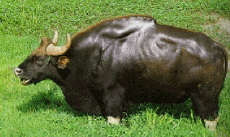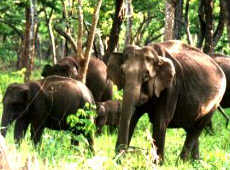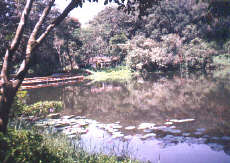Kerala: More to It Than Backwaters
Wynad, India


It outstared us, the wild bison, or gaur, at Muthunga wildlife sanctuary.
![]()
![]()
“Be different.” This is my motto in life. So, when friends learned that I was planning a trip to “God’s own country” (the State government of Kerala has sure come up with a catchy slogan!), all they could conjure up was visions of me lazing on a houseboat in the backwaters.
But, being the monsoon season (the rainy season in India lasts from June to September), I did not find the idea of rough backwaters very appetizing, nor that of kids running around and clamoring for pens when the houseboat sailed past a village.
I wanted to get away from it all – peace and quiet for an entire week, is what I sorely needed. I sure found it. Surprise, surprise, there is no mobile connectivity in Wynad, a hill station (700 meters above sea level) of Kerala, much to my happiness and the chagrin of the folks who could not contact me. Of course, land telephone lines exist and so does Internet connectivity, but then it was for me to use these facilities as and when I wanted to.
Wynad it was, just a seven-hour drive (with a few halts on the way) from Bangalore. Cutting across Bandipur Wildlife Sanctuary in Karnataka State, we drove across a tiny bridge on National Highway (NH) 212 to reach Muthanga Wildlife Sanctuary in Kerala. Only the elephants that criss-cross the states of India do not have to pay any road tax on entering another state!


Elephant herd spotted on the way to Wynad, Kerala.
![]()
![]()
In fact, to our delight, a huge herd of elephant Mum’s and Aunt’s crossed the road (the NH 212 cuts across the Bandipur and Muthanga wildlife sanctuaries) while we were driving down. A huge towering aunt glowered at us as she was protecting a cute little naughty baby elephant. It would have been foolish to step down and click pictures, and of course my hands were trembling because elephants can also attack. But I managed to click, at somewhat of an awkward angle after rolling down the car panes. Hope this snap comes out good.
The main reason for selecting Wynad was to see the teeming wildlife. This district town nestles in the lush rain forests; everywhere you glance there is greenery. There are so many different shades of green. Enough to turn the folks slogging at the office green with envy. Aaah, vacations between a job-hop are bliss.
Close to Wynad, in Kerala state are two wildlife sanctuaries. Muthanga and Tholpettey. Besides, two others in Karnataka and Tamil Nadu respectively are also reachable by car. All of them are teeming with elephants, spotted deer or chital, wild bison, tigers and a host of birds (most of them I could not identify, but drew hasty sketches. I will now identify them, as I am armed with Salim Ali’s Book of Indian Birds).
The Ghost That Once Was
You touch Kerala and you know that you are in another state. The attire of the men changes to that of white crisp lungis (sheets of cloth wrapped around the waist), and the air suddenly seems more “wet”; humid is not the right word to describe it, as the smell of wet earth and the moisture which clings in the air is indeed pleasant. Banana plantations and coconut groves are everywhere, as are coffee and tea estates.
To me, as I am originally from Bombay, both Kannada (the language spoken in Bangalore, Karnataka state), and Malayam (the local language of Wynad, Kerala state), sound the same and more so, look the same. Each signpost seemed as vague as it does in my current place of residence Bangalore.
With language posing to be a bit of a problem, the majority of the locals do not speak English or, for that matter Hindi, so it is best to find a hotel that manages not only your boarding and lodging but also your trekking and sightseeing activities. And, we were lucky in this respect, to find a comfy hotel tucked away in the greenery of NH 212.
Now, I just have to mention Manjunath, the general manager at Green Gates Hotels. He was a bit too embarrassed to narrate the legend behind the Chain tree, fully aware perhaps that city slickers scoff at ghosts and ghost stories. But finally after much goading, he did narrate the legend.


The Pookot Lake.
![]()
![]()
Intrigued, we decided to begin our tour with the Chain tree. Near the Pookot Lake (a large freshwater lake with boating facilities), lies a big Peepal tree with two heavy chains hanging from its boughs. These chains are actually attached to a big seal in the ground. Legend has it that, decades ago, a British engineer killed an advisai (tribal) who had shown him the path through the mountains to reach the fertile Wynad district. The engineer wanted to take full credit for having discovered fertile Wynad.
The Adivasi’s ghost then haunted travelers proceeding to Wynad. Bullock carts came to a standstill mid-way, and the animals refused to go further. A priest then tied down this ghost, and sealed it.
We also learned that the chain tree does not grow. And ill befalls anyone who tries to cut it. I stood at a respectful distance and clicked snaps.
Going Wild
Lakkidi, where the Chain tree stands, is the gateway to Wynad district. Having seen it, we decided to do what we had actually come for: see the teeming wildlife.
Early morning, with Anthony (an experienced driver provided by the hotel), we set off in a jeep to Muthanga. A good one-hour drive at fast speed from the hotel (the sanctuary is 35 kilometers away) ensured that we reached the sanctuary right on time at 7 am. Certain categories of jeeps are allowed in the sanctuary, but hiring a forest guard is a must (see tips at the end of the story).
So Mohan came aboard and we set off. The first thing we spotted was the brightly colored jungle fowl (similar to domestic hens but smaller and vibrantly colored) and quails scampering around on the grass besides the rough pathway into the forest. Then came a big herd of young chital (spotted deer); they stared at us with curiosity and then scampered away on their morning walk. The sanctuary officials, to facilitate sighting of wildlife, regularly clear the forest patch along the very narrow rough road. Green grass grows here, attracting herds of chital.
Anthony drove carefully and slowly. Disembarking from the jeep is an absolute “No-No”. But Mohan kept looking around sharply, and concentrated on the crackling of dry leaves, twigs and even the fall of a single leaf.
So we ended up seeing herds and herds of chital, they took off gracefully in flight on seeing us approach near. We also saw a pack of wild dogs that were caught sunning themselves. Fortunately they stayed, if only for a minute, long enough to enable me to go click-click with my camera.
Turning a corner we saw a huge big solitary wild bison. He stopped and stared. We started back, while I fumbled for my camera. I did manage to get a picture, but sadly I know that the bull was partly hidden by the foliage. The big animal out-stared us, and at Mohan’s behest we hurriedly drove on.
Monkeys and their antics cheered us to no end. It was difficult to spot the birdlife, as it is tough to crane your neck upwards from the jeep.
But a few peacocks strutting about in the foliage had us asking for more. We were reluctant to leave. But Mohan mentioned to Anthony, who was also acting as the interpreter, that he had not seen elephants here lately. They seemed to have moved away to the Karnataka part of the sanctuary (Bandipur).
So we headed back to the hotel, stopping on the way to see a tusker in the midst of a field. Don’t know whether it was plundering the field or was a tame elephant. Your guess is as good as mine.
And as for the tiger, it remained elusive. We did not spot one, even though we paid another trip to the sanctuary. Anthony mentioned that there are better chances of spotting it at the Tholpetty Wildlife Sanctuary, 62 kilometers away from the hotel, as this sanctuary has fewer waterholes. Well, I shall attempt to have a date with the tiger on my next trip.
——–